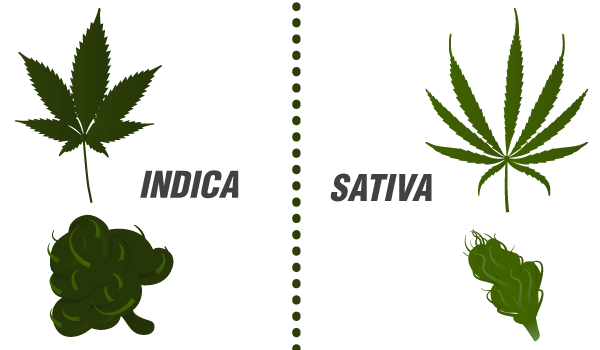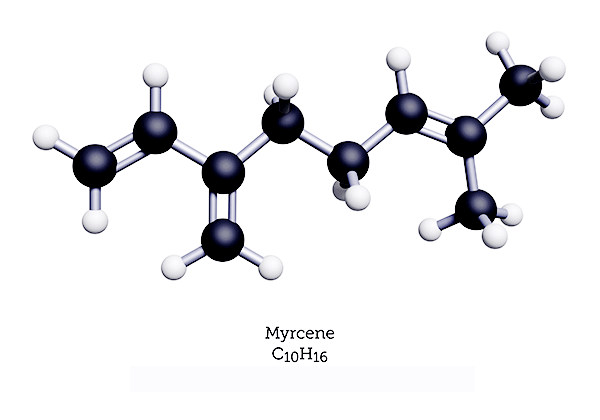Spotting The Differences Between Indica Vs. Sativa Plants And Buds
Published :
Jul 3, 2019
Categories :
Strain information

The differences between indica and sativa have long fueled debate within the cannabis community. But how do you really differentiate indica and sativa cannabis? Read on to find out.
Sativas are uplifting and indicas are sedating, right? Well, not really. There’s a lot more to the age-old sativa vs. indica debate. In this article, we’ll show you the differences between indica and sativa cannabis plants, and teach you how to tell them apart both in the grow room and when buying bud.
HOW TO DISTINGUISH SATIVA AND INDICA PLANTS
Spotting the difference between indica and sativa plants can be difficult for inexperienced growers. However, once you know what to look for, indicas and sativas become pretty easy to tell apart.
Start by looking at the height and stretch of your plants. Indicas tend to be shorter and bushier, reaching a height of around 60–180cm, whereas sativas grow tall and can reach a height of well over 200cm.
Another way to tell the difference between sativas and indicas is to look at their leaves. Sativas tend to have narrow-fingered leaves with a light green colour. Indicas, on the other hand, have broader leaves with wider fingers and tend to be dark green in colour.
Finally, one telltale sign of sativas is their long flowering cycle. Depending on their genetics, sativa strains can take 10–16 weeks to mature, whereas indicas typically flower within 7–9 weeks.

DISTINGUISHING SATIVA AND INDICA BUDS
Just like indica and sativa plants look different, they also produce different flowers. Sativas tend to produce long buds that look wispy or fluffy, and weigh less to boot. Indicas, by contrast, tend to grow in tight clusters closer to the nodes of the plant. They are denser and, although they might be shorter in length, tend to be heavier than sativa buds once on the scale. Indica strains are also less susceptible to cold climates, and sometimes develop eye-catching purple or red hues when exposed to lower temperatures.
DO INDICAS AND SATIVAS SMELL DIFFERENT?
Some cannabis enthusiasts also claim that sativas and indicas smell different—and they could be onto something. Terpenes are what give cannabis its unique and complex aromas, and some research shows that indicas and sativas may indeed have different terpene profiles.
Research by Fundacion Canna, for example, analysed the chemical profiles of 99 different cannabis strains. It was found that myrcene was the dominant terpene in almost every strain, but the study also highlighted that there were some stark differences in the terpene profiles of indica and sativa varieties.
The researchers found, for example, that the indica-dominant varieties in their trial had higher relative concentrations of camphene, myrcene, and limonene. The sativa varieties, on the other hand, contained higher relative concentrations of sabinene, carene, α-Phellandrene, cineole, and terpinolene. Below is a bit more information about these individual terpenes and how they might affect the smell of different strains of cannabis.
• Camphene is commonly found in dill, caraway, hyssop, and fennel, and has a camphor-like odour.
• Myrcene is commonly used in cleaning products and fragrances, and has a kind of musky, earthy aroma.
• Limonene is found in citrus peels and has a strong citrus aroma.
• Sabinene can be found in many plants including black pepper, basil, spruce, and more. It has a woody aroma and flavour.
• Carene can be extracted from bell peppers, grapefruit, citrus peels, and more. It has a sweet, pungent, citrusy-pine aroma.
• α-Phellandrene can be isolated from some eucalyptus species. It has a minty-citrus aroma.
• Cineole, also known as eucalyptol, can also be extracted from eucalyptus, camphor laurel, bay leaves, rosemary, and more. It has a fresh, minty aroma and a cool, menthol-like taste.
• Terpinolene can be isolated from a variety of plants and has a floral, slightly herbaceous aroma.
The different concentrations of these terpenes may give indica and sativa strains notably different aromas. Make a habit of smelling your cannabis and trying to spot the different aromatic properties of different strains.

TIPS FOR SPOTTING THE DIFFERENCES BETWEEN INDICA AND SATIVA CANNABIS
A lot of people think the differences between indica and sativa strains lie in their effects. And sure, some sativas tend to produce more uplifting effects, while some indicas tend to be more relaxing. But the high you get from a particular strain has to do with the plant’s chemical profile, and not its taxonomy.
Hence, if you’re trying to learn more about differentiating cannabis varieties, try thinking about the different origins of indica and sativa strains, not just the physiological effects they produce.
Cannabis indica is believed to be native to cooler regions, like the mountainous regions of Nepal, Afghanistan, Pakistan, and India, while Cannabis sativa is believed to originate from the humid climates of Southeast Asia. To deal with the high heat and humidity of these regions, Cannabis sativa evolved to grow taller, less bushy, and produce lighter, airier buds that are less susceptible to mould and bud rot. With long summers, these plants have also evolved to flower for a longer period.
The traits that characterise Cannabis indica are also evolutionary. The regions of Central and Southern Asia are typically dry, with a stark seasonal rise in humidity around October. To avoid this high humidity, Cannabis indica adapted by flowering for a shorter period of time.
A NOTE ON HYBRIDS
Most of the cannabis you’ll find on the street or at a dispensary is the product of a lot of crossbreeding. Crossbreeding became really popular in the 1970s and 1980s because it allowed cannabis growers and seed banks to manipulate the genetics of their cannabis plants to suit their needs.
Today, most strains contain a mix of both indica and sativa genetics. That’s because indicas really changed the game when it comes to cannabis cultivation. Thanks to their shorter flowering time, heavy buds, and more compact structure, indicas are much better suited for indoor cultivation. Plus, their denser buds look very attractive and tend to fetch a higher price than their sativa counterparts. As such, a combination of sativa and indica genetics allows for the best traits of both strains to be expressed, while keeping flowering times reasonable.






































